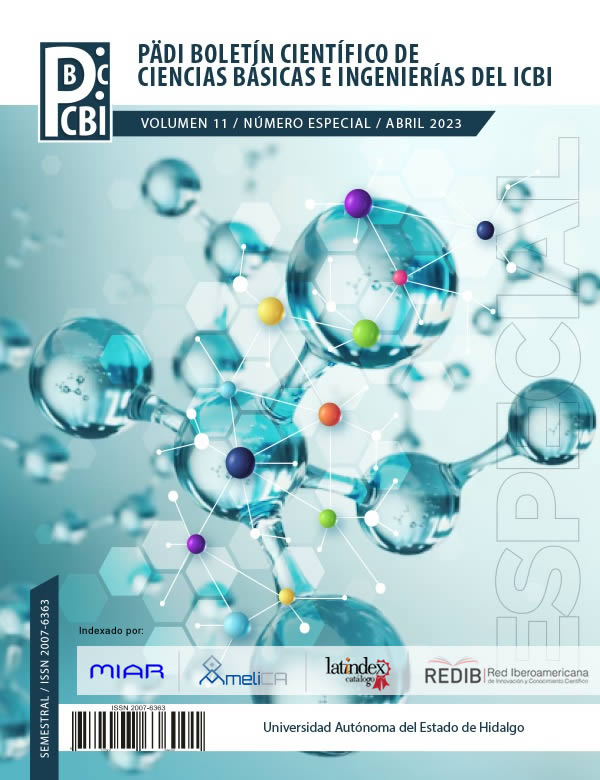Spectroscopic evaluation of the coagulation process of humic acids in the presence of Fe3+
DOI:
https://doi.org/10.29057/icbi.v11iEspecial.10230Keywords:
humic acids, iron interaction, coagulation, humic, acids, ironAbstract
Humic acids (HAs) are the main and most abundant components of organic matter (OM), they were evaluated by spectroscopic parameters, after a process of agglomeration, coagulation and microfiltration in the presence of iron (Fe3+) as a coagulant agent and by means of quantification with the calibration method. Additionally, the behavior of humic macromolecule in presence of metal was analyzed physicochemically and adjusting the pH to 5 to favour the deprotonation of the carboxylic groups (- COOH), stabilizing the negative charges with a minimum but effective Fe3+salt (3 mM) concentration. Managing to eliminate an average of 96% the HA as OM in solution. The kinetics of HA-Fe interaction process were very short, less than 5 min. The spectra show a great similarity in relation to the absorbances, however, it is recommended to carry out the microfiltration in the first 30 min of reaction.
Downloads
Publication Facts
Reviewer profiles N/A
Author statements
Indexed in
- Academic society
- N/A
References
Almendros, G. (2008). Revisión analítica de sustancias húmicas en suelos y compost. soilACE 239-255. Recuperado el 2 de mayo de 2018 de: https://www.soilace.com/pdf/pon2008/d26/Cas/04_GAlmendros.pdf.
Barrenechea, M. A. (2004). Coagulación de Materia Orgánica (Capítulo 4). Lima. Recuperado el 13 de junio de 2022 de: http://www.ingenieroambiental.com/4014/cuatro.pdf
Basu, A., Saha, D., Saha, R., Ghosh, T., Saha, B. (2014). A review on sources, toxicity and remediation technologies for removing arsenic from drinking water. Research on chemical intermediates 40, 447-485. (2018). Two-dimensional correlation spectroscopic analysis on the interaction between humic acids and aluminum coagulant. Journal of Environmental Sciences 64, 181-189.
Buschmann, J., Kappeler, A., Lindauer, U., Kistler, D., Berg, M., Sigg, L. (2006). Arsenite and arsenate binding to dissolved humic acids: influence of pH, type of humic acid, and aluminum. Environ. Sci. Technol., 40, 19, 6015–6020.
Carpio, D. K. (2017). Análisis fisicoquímico de ácidos húmicos y evaluación cinética de su agregación con iones Na+, Ca2+ y Mg2+. Tesis de Licenciatura, Universidad Autónoma del Estado de Hidalgo, México.
Chin, Y. P., Alken, G., Loughlin, E. O. (1994). Molecular weight, polydispersity, and spectroscopic properties of aquatic humic substances. Environ. Sci. Technol 28, 1853 – 1858.
Gomes-de Melo, B. A., Lopes-Motta, F., Andrade-Santana, M. H. (2016). Humic acids: Structural properties and multiple functionalities for novel technological developments. ScienceDirect 62, 967-974.
He, Z., Traina, S. J., Weavers, L. (2007). Sonolytic desorption of mercury from aluminum oxide: effects of pH, chloride and organic matter. Environ. Sci. Technol 41, 779-784.
Kloster, N., Brigante, M., Zanini, G., Avena, M., (2013). Aggregation kinetics of humic acids in the presence of calcium ions. Colloids and Surfaces A: Physicochem. Eng. Aspects 427, 76 - 82.
Kononova, M. M. (1982). Materia orgánica del suelo. 1ª Ed. Oikos-tau, Barcelona, España, 63-105.
Kucerík, J., Kovár, J., Pekar, M. (2004). Thermoanalytical investigation of lignite humic acids fractions. J. of Termal Análisis and Calorimetry 76, 6242-6252.
Lead, J. R., Starchev, K., Wilkinson, K. J. (2003). Diffusion coefficients of humic substances in agarose gel and in water. Environ. Sci.Technol 37(3), 482-487.
Licona, S. T. J. (2007). Extracción y análisis fisicoquímico de ácidos húmicos y su interacción con Cu(II) y Pb(II). Tesis de Licenciatura, Universidad Autónoma del Estado de Hidalgo, México.
Ma, J., Guo, H., Weng, L., Li, Y., Lei, M., Chen, Y., (2018). Distinct effect of humic acid on ferrihydrite colloid-facilitated transport of arsenic in saturated media at different pH. Chemosphere 212, 794-801.
Nieto, V. S. (2010). Estabilidad de los ácidos húmicos y su influencia en la interacción con Cu(II) y Pb(II). Tesis de Doctorado, Universidad Autónoma del Estado de Hidalgo, México.
Nieto, V. S. (2017). Evaluación del efecto de las cinéticas de agregación de los ácidos húmicos (AHs) en presencia de Na+, Ca2+ y Mg2+. Revista Tendencias en Docencia e Investigación en Química 3, 154 – 162.
Nieto-Velázquez, S., Villagrán-Manilla, A., Ibarra-Coria, E. D. (2019). Evaluación y análisis de cinéticas de agregación de los ácidos húmicos en presencia de Al3+ por espectroscopi UV-VIS. Tópicos de Investigación en Ciencias de la Tierra y Materiales, 6, 72-79.
Pacheco, M. L. (2002). Capillary Electrophoresis and MALDI-TOF mass spectrometry of humic acids. Tesis de Doctorado, Departamento de Química Analítica, Facultad de Ciencias, Universidad de Masaryk, República Checa.
Pengkang, J., Jina, S., Xiaochang, C. W., Xin., J. (2018). Two-dimensional correlation spectroscopic analysis on the interaction between humic acids and aluminum coagulant. Journal of Environmental Sciences. 64, 181-189
Schnitzer, M. (1991). Soil organic matter. Soil Sci. 151, 41 – 58.
Schulten, H. R., Hempfling, R. (1992). Influence of agricultural and management on humus compositon and dynamics: Classical and modern analytical techniques. Plant Soil 142, 259 – 271.
Shunan, D., Wangwei, C., Jihong, X., Liting, S., Weimu, W., Hui, L. (2021). Aggregation kinetics of fragmental PET nanoplastics in aqueous environment: complex roles of electrolytes, pH and humic acid. Environmental Pollution 268.
Troconis, A. (2010). Tratamiento de aguas residuales. Recuperado 14/05/2021 https://www.belzona.com/es/solution_maps/wastewater/money_map.pdf
Watson, M. A., Tubić, A., Agbaba, J., Nikić, J., Maletić, S., Molnar, Jazić, J., Dalmacija, B., (2016). Response surface methodology investigation into the interactions between arsenic and humic acid in water during the coagulation process. J. Hazardous Materials 312, 150-158.




















